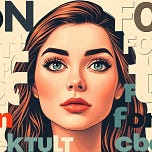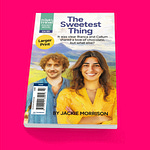“I heard that writing in comic sans works well for writers, is that true?”
I read a Note from one of my followers asking for recommendations for the type of font folks were writing in.
Does it matter?
I rather like the one we’re writing in here at Substack and I imagine quite a bit of research went into that!
You see, font really does matter and there are whole studies on it.
History of font is amazingly interesting to a nerd like me. So much so that I once spent more than half a day at an exhibition at the Design Museum in London which was all about the history of the changing face of the Guardian newspaper.
They relaunched themselves with a new look when they moved from broadsheet (those huge big newspapers) into a more modern, tabloid size. With that, they altered their whole appearance - from the Masthead, down to the arrangement of text on each page. It was a complete overhaul and FONT and layout was one of the major alterations. It still looks iconic and recognisable to this day. (I’ve popped a link at the bottom about this).
Another iconic type of font is found on the Kindle. Bookerly recently replaced the original Caecilia font. Kindle asserts that Bookerly, a serif typeface, designed by Dalton Maag for the Amazon Kindle e-reader helps the user “read faster with less eyestrain.”
(From: Amazon/Kindle website)
As writers, we will be asked to submit in a normal font, most usually times new roman or arial and size 12 or 14 with 1.5 - 2 line spacing with wide margins (not narrow - even on your synopsis - no cheating!). This harks back to the old days when manuscripts were in paper form and notations were made between the lines and in the margins. You can see examples of this kind of editing in Stephen King’s book On Writing - although that was his own editing! An editor needs space to do that. Setting your manuscript out that way allows space around the words for the reader to follow along easily. I don’t think editors write on paper like that anymore - it’s likely all done on the computer. However, those font types are widely used in office settings and cause less fatigue to the reader as they are “expected” forms.

So, why write in any other font? Well, I have some suggestions for that.
Times New Roman and Arial breed familiarity. Your brain is so used to seeing it, you may skp over words (skip over words - see what I did there?) and start to un-see errors completely. Skim-reading.
Personally, I find it helpful to bang out my idea in whatever font my device is set for (whether that’s email, my phone or my laptop) but when I come to work on the skeleton draft for a story, I may shift it into something else - Comic Sans or Garamond or something that goes with the story! When I edit, I shift it back again. When I submit, I ensure it is set exactly as the recipient wants it.
Why make these changes? It’s about making the brain pay attention.
I like a playful font for creating.
And a serious, business-like font for editing!
Comic Sans is chosen by many as being playful and allowing your brain to connect to a childlike playful manner - to take yourself less seriously and to let you unravel your thoughts onto the page without feeling too serious about it. Even if you are writing serious matter! There is also some evidence that Comic Sans in particular can make our brain pay more attention - something about it being unusual to read in this font. Or to write in it, I’d hazard a guess!
I wrote a story that featured a typewriter and to get “into character” I used an old-fashioned font more suited to a manual typewriter.
If you are writing Sci-Fi or Fantasy, you may choose a font type appropriate to your material. There are plenty to choose from.
If you want to puzzle yourself as well as everyone else, try typing a paragraph up in WingDings, and don’t look at it until you have completed the whole thing. That will definitely stop you going back and fixing typos!! You will only see what you wrote when you alter the font back to TNR or similar! I’m not sure I’m ready for that experiment yet!
I’m in the midst of the first messy draft, my skeleton draft if you will, and I’m willing to try anything that keeps me at it! I know from experience that, for me, to keep going whilst I’m motivated is the best chance of me getting to the end of the first draft. I don’t care what font it is in, or what it looks like - I know I will have something to work with.
You see, I was very disappointed a few years back when I realised that the completed first draft is not your final novel. Oh, dear. Yes, I thought perhaps with a pass of copy editing it would be fine. Not so. That’s because I had been a complete pantster and my structure was all over the place.
I’ve learned a lot since then - I learned by writing. Then writing some more. And even more. I didn’t stop at writing. I got feedback. I got some critiques. Then, I started planning. Now I know to expect my first draft to need work. Now I know that piece of writing will have glimpses of brightness but will need proper cleaning, polishing, and even a bit of cutting like a diamond - perhaps even a nice setting to hold it all in, and a lot of skill to make it the best it can be.
But first the zero draft, the messy draft, the first draft! I’m getting there. I’m one-third of the way in. How about you? It’s still a long way from ever being printed off!

I’m fascinated by print. One of my classes in journalism college in Edinburgh entailed a visit to the type-setting rooms where the students (I seem to remember every single one of them was male) were placing individual little pieces of metal into trays ready for a printing machine. We also visited The Scotsman newspaper offices in the days before it was transformed into a hotel. An imposing stone building rising high above Waverely Train Station in central Edinburgh, the racket in the downstairs areas where printing took place was amazing. All ironmongery, ink, and large crashing plates. I’d guess that many of the folks who worked down there now have a hearing problem.
In the old days, font mattered, the number of characters mattered and what fitted on a page mattered. It’s funny, as we are coming back to those days, because of the price of paper.
So, will you play around with font?
Perhaps when you sit down to create - surprise yourself by using a different font and the playfulness may help get you over a block. Just type yourself a sentence or two in a different font. I am looking at…… and off you go. Dear Mother….off you go. Dear Girl In The Photo….off you go.
Heck, sometimes it’s even fun to do different POV characters in different fonts, just for the fun and brain-cheer of it. But do remember to change it all back before submitting or you just might make an agent or publisher groan!
In the past, I’ve varied between normal font and italics for different POVs in a novel. It goes without saying, that the narrator voice for each character should be strong enough not to rely on tricks like font-types (sorry, not sorry). Use it for your own purposes but don’t expect anyone else to want to see anything but a font or print which is “the norm”.
When my Pocket Novel comes out in June it will be a different font and different spacing and that is because the Pocket Novel is in larger print. We might think this is because the target audience is older.
Ulverscroft Publishing recently cited their reasons for producing large print:
There's more to Large Print than meets the eye...
It can make reading easier, calmer and more accessible for so many different people – including those with neurodivergence, dyslexia, or who are reading in English as a second language.
Sometimes, the best format is the one that feels easiest.
And for many, that’s Large Print.
(Ulverscroft Publishing)
I am sure that sub-consciously or not, many people enjoy writing in Substack because of decisions taken about how the page looks when we type. The spacing, the font choices, and how lovely it feels to progress down the page at this pace.
I realise some people who dislike it - mostly they will be experienced writers with their own websites/writing spaces - and they will have chosen to change the look of their pages to be more “their brand”.
Coz let’s face it, we are unwittingly writing our own stuff with a Substack Brand appearance! I’m not complaining. I like it.
Have you noticed how lovely it is? How cool and spacious your page feels? Thanks to the Substack background folks who made those decisions!
Maybe one day we’ll see an exhibition about this. Substack - the growth of the online newsletter!
Have fun with your fonts this week folks! I’d be interested to hear how you get on!!
Meantime, I’m away to do the same for the next chapter of the novel I’m writing. See, I wrote this to give myself the push on the novel I’m writing - I’m away to write a chapter in a different font. Hopefully, it may help you too!
Thanks for being here, Jackie, in the Little Writing Corner in Scotland x

LINKS
The Ugliness Of Comic Sans Has A Practical Use
Re-branding of The Guardian newspaper
Friday 9 February - Sunday 6 May 2018
Print in the digital age: Redesigning The Guardian newspaper
A free pop-up display exploring the design process behind The Guardian’s new tabloid format.Ulverscroft large print statement
Ulverscroft Instagram Page - statement about large print















Share this post